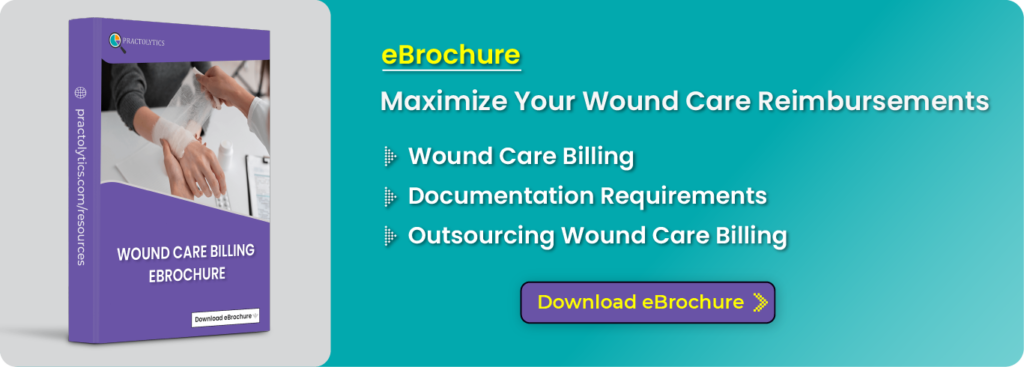Optimizing Reimbursements in Wound Care strategies for RCM Efficiency
Wound care reimbursements is a critical aspect of healthcare, encompassing a wide range of conditions from simple cuts and scrapes to complex, chronic wounds. With the growing prevalence of chronic conditions like diabetes and an aging population, the demand for wound care services is on the rise. However, for healthcare providers, optimizing reimbursements for wound care treatments can be a complex and challenging task. In this blog post, we’ll explore strategies for maximizing revenue cycle management (RCM) efficiency in wound care, ensuring that providers receive fair reimbursement for the vital services they provide.
Table of Contents
Understanding the Reimbursement Landscape in Wound Care
Before delving into specific strategies, it’s essential to have a clear understanding of the reimbursement landscape in wound care. Reimbursement for wound care services typically comes from a variety of sources, including private insurance, Medicare and Medicaid. Each payer may have its own set of rules, guidelines, and reimbursement rates, making the process intricate and multifaceted.
Additionally, reimbursement rates can vary based on factors such as the complexity of the wound, the type of treatment provided, and the setting in which the care is delivered (e.g., outpatient clinic, skilled nursing facility, or home health). Understanding these nuances is crucial for accurately billing and maximizing reimbursements.
Leveraging Coding Accuracy in Wound Care
One of the most critical factors in optimizing reimbursements is ensuring coding accuracy. Proper coding allows healthcare providers to accurately describe the services rendered, which in turn ensures appropriate reimbursement. In wound care, accurate coding relies on detailed documentation of the wound’s characteristics, including its size, depth, location, and any associated complications.
Healthcare providers should utilize specific codes from the International Classification of Diseases, Tenth Revision, Clinical Modification (ICD-10-CM) and Current Procedural Terminology (CPT) code sets to accurately capture the nature of the wound and the procedures performed. Regular training and education for coding staff can help ensure compliance with coding guidelines and maximize reimbursement potential.
Documentation Excellence to Maximize Wound Care Reimbursements
In addition to accurate coding, comprehensive documentation is essential for maximizing reimbursements in wound care. Detailed documentation not only supports the codes billed but also demonstrates the medical necessity of the services provided. This is particularly important when dealing with complex wounds or chronic conditions where ongoing care is required.
Providers should ensure that documentation includes thorough descriptions of the wound, including its etiology, size, depth, and any underlying conditions affecting wound healing. Additionally, documentation should clearly outline the treatment plan, including the rationale for specific interventions and any changes in the patient’s condition over time.
Utilizing Technology Solutions
Technology can play a significant role in streamlining RCM processes and maximizing reimbursements in wound care. Electronic health record (EHR) systems with built-in coding and documentation tools can help automate the coding process, reducing errors and ensuring compliance with coding guidelines. These systems can also facilitate communication and collaboration among members of the healthcare team, ensuring that all relevant information is captured and documented.
Furthermore, advanced analytics and reporting capabilities offered by some EHR systems can provide valuable insights into reimbursement trends, allowing providers to identify areas for improvement and optimize their RCM strategies accordingly. By leveraging technology solutions, healthcare providers can enhance efficiency, accuracy, and ultimately, reimbursement outcomes in wound care.
Staying Updated on Regulatory Changes
The healthcare landscape is constantly evolving, with new regulations, guidelines, and reimbursement policies being introduced regularly. Staying abreast of these changes is essential for healthcare providers looking to optimize reimbursements in wound care.
Providers should regularly monitor updates from payers such as Medicare and Medicaid, as well as industry organizations like the Centers for Medicare & Medicaid Services (CMS) and the American Medical Association (AMA). By staying informed about changes to coding rules, reimbursement rates, and documentation requirements, providers can proactively adjust their RCM strategies to ensure compliance and maximize reimbursement potential.
Emphasizing Patient Education and Compliance
Effective wound care requires active participation from patients, including adherence to treatment plans, wound care instructions, and lifestyle modifications. Educating patients about the importance of compliance and providing clear, actionable instructions can help improve outcomes and reduce the risk of complications, ultimately leading to more efficient wound healing and lower healthcare costs.
Providers should take the time to educate patients about their wounds, including the factors influencing healing, the importance of proper wound care techniques, and the signs of potential complications. By empowering patients to take an active role in their care, providers can improve treatment adherence, reduce the likelihood of rehospitalization, and ultimately, enhance reimbursement outcomes.
In short, optimizing reimbursements in wound care requires a multifaceted approach that encompasses accurate coding, comprehensive documentation, technology utilization, regulatory compliance, and patient engagement. By implementing strategies to enhance RCM efficiency, healthcare providers can ensure that they are fairly reimbursed for the critical services they provide while delivering high-quality care to patients in need.
In an ever-changing healthcare landscape, staying proactive and adaptable is key to success. By continuously refining RCM processes and staying informed about industry developments, healthcare providers can position themselves for long-term success in wound care reimbursement optimization. Through a combination of strategic planning, education, and technology integration, wound care providers can navigate the complexities of reimbursement and maximize their financial outcomes while delivering optimal patient care.
As healthcare providers navigate the complexities of optimizing reimbursements in wound care, partnering with innovative solutions like Practolytics can significantly enhance their RCM efficiency. Practolytics offers cutting-edge technology solutions designed to streamline coding, documentation, and billing processes, allowing providers to focus on delivering high-quality care while maximizing their reimbursement potential. With Practolytics’ advanced analytics and reporting capabilities, providers gain valuable insights into their RCM performance, identifying areas for improvement and implementing data-driven strategies to enhance financial outcomes. By leveraging Practolytics’ expertise and technology, healthcare organizations can navigate the evolving reimbursement landscape with confidence, ensuring optimal reimbursement while delivering exceptional wound care services to their patients.
ALSO READ – Efficient and Error-Free Wound Care Billing: Unveiling the Practolytics Method
Talk to Medical Billing Expert Today — Get a Free Demo Now!






